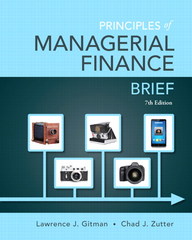Question
1 Consider a risky asset that has two possible payoffs in a year's time: Outcome Probability Payoff Good .5 $200,000 Bad .5 $70,000 Your alternative
1 Consider a risky asset that has two possible payoffs in a year's time: Outcome Probability Payoff Good .5 $200,000 Bad .5 $70,000 Your alternative is to invest in a risk-free asset (a T-bill) that returns 6% per year in either state. Based on your coefficient of risk aversion you require a risk premium of 8% on the risky asset. Assume the risky asset is actually trading for $120,000. What is the expected rate of return on the risky asset? Please enter your answer in percent rounded to the nearest basis point.
1b)
Consider a risky asset that has two possible payoffs in a year's time:
| Outcome | Probability | Payoff |
| Good | .5 | $200,000 |
| Bad | .5 | $70,000 |
Your alternative is to invest in a risk-free asset (a T-bill) that returns 6% per year in either state. Based on your coefficient of risk aversion you require a risk premium of 8% on the risky asset.
Assume the risky asset is actually selling for the maximum price you would be willing to pay for it given your required risk premium. What is the expected rate of return on the risky asset? Please enter your answer in percent rounded to the nearest basis point.
1c)
Consider a risky asset that has two possible payoffs in a year's time:
| Outcome | Probability | Payoff |
| Good | .5 | $200,000 |
| Bad | .5 | $70,000 |
Your alternative is to invest in a risk-free asset (a T-bill) that returns 6% per year in either state. Assume the risky asset is actually selling for $110,000. If your utility function is as described in the book/lecture , then what is the maximum coefficient of risk aversion at which you would still prefer to invest in the risky asset rather than in the risk-free asset? Please enter your answer rounded to the third decimal place.
1d)
| Asset | Expected Return E(r) | Standard Deviation sigma |
| 1 | 0.12 | 0.3 |
| 2 | 0.15 | 0.5 |
| 3 | 0.21 | 0.16 |
| 4 | 0.24 | 0.21 |
If your utility function is as described in the book/lecture with a coefficient of risk aversion of 4.0 , then what is the second-lowest utility you can obtain from an investment in one (and only one) of these assets? Please calculate utility using returns expressed in decimal form (e.g., use .12, not 12 for the expected return of Asset 1). Please enter your answer rounded to the third decimal place.
Step by Step Solution
There are 3 Steps involved in it
Step: 1

Get Instant Access to Expert-Tailored Solutions
See step-by-step solutions with expert insights and AI powered tools for academic success
Step: 2

Step: 3

Ace Your Homework with AI
Get the answers you need in no time with our AI-driven, step-by-step assistance
Get Started


